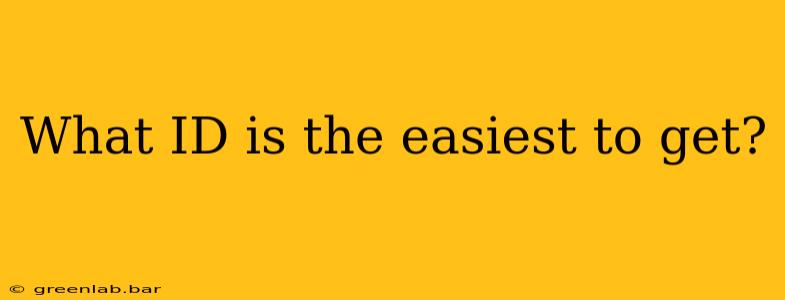What ID is the Easiest to Get? A Comprehensive Guide
Getting a government-issued ID can feel daunting, especially if you're unsure where to start. The "easiest" ID to obtain depends heavily on your individual circumstances, such as your age, residency status, and access to necessary documentation. This guide breaks down the common ID options and clarifies the requirements, helping you determine the most accessible path for your specific situation.
Understanding the "Easiest" Concept: It's crucial to understand that "easiest" doesn't imply a lack of rigor. All legitimate IDs require proof of identity and residency. The ease lies primarily in the accessibility of required documents and the simplicity of the application process. This guide focuses on navigating these aspects for various ID types.
Common ID Options and Their Relative Ease:
1. State-Issued Driver's License or ID Card:
- Ease of Obtaining: This is generally considered one of the easier options for US residents, particularly if you already have a permit.
- Requirements: Typically requires proof of identity (birth certificate, passport), residency (utility bill, lease agreement), and a driving test (for a driver's license). The specific requirements vary by state.
- Pros: Widely accepted, carries significant weight as proof of identity.
- Cons: Requires a driving test (for a license), might have longer wait times depending on the state's DMV.
2. State-Issued Identification Card (Non-Driver):
- Ease of Obtaining: Similar in ease to a driver's license, but without the driving test requirement.
- Requirements: Proof of identity and residency are paramount. Specific documentation requirements vary by state.
- Pros: Accepted in most places requiring photo ID, suitable for those who don't drive.
- Cons: Still needs documentation proving identity and residency; processing time may vary.
3. Passport Card:
- Ease of Obtaining: Obtaining a passport card can be relatively straightforward, especially if you already have a passport.
- Requirements: Requires proof of US citizenship (birth certificate or previous passport) and a completed application.
- Pros: Accepted domestically as photo ID and is helpful for travel within North America.
- Cons: Requires a government application process and the associated fees.
4. Military ID:
- Ease of Obtaining: Relatively easy for active-duty military personnel and veterans.
- Requirements: Active duty status or veteran status in the US military.
- Pros: Widely accepted as photo ID and proof of identity and residency.
- Cons: Only applicable to those serving or who have served in the US military.
5. Tribal ID:
- Ease of Obtaining: The process varies greatly between tribes, but generally requires proof of tribal membership.
- Requirements: Proof of tribal affiliation, sometimes additional documentation.
- Pros: Recognized as photo ID within certain jurisdictions.
- Cons: Acceptance varies widely depending on the issuing tribe and the entity requiring identification.
Factors Affecting Ease of Obtaining an ID:
- Access to Documentation: Having readily available birth certificates, social security cards, and proof of address significantly simplifies the process.
- Transportation: Getting to the relevant agency (DMV, passport acceptance facility) may present a challenge for some.
- Language Barriers: Language assistance is often available, but it's essential to confirm.
- Financial Resources: Fees for applications and processing can be a barrier for some individuals.
Disclaimer: This information is for general guidance only and doesn't constitute legal advice. Always check with the relevant issuing authority for the most up-to-date requirements in your specific location. The ease of obtaining an ID is subjective and depends on various individual factors.

